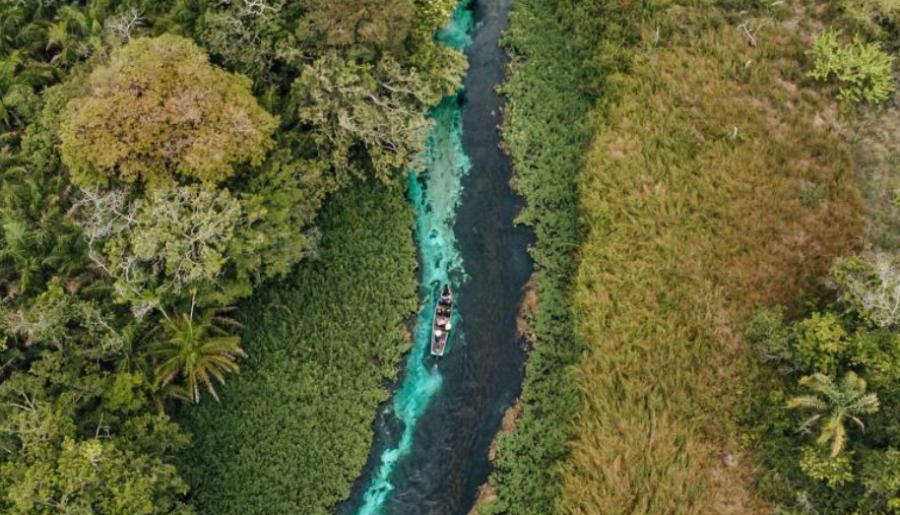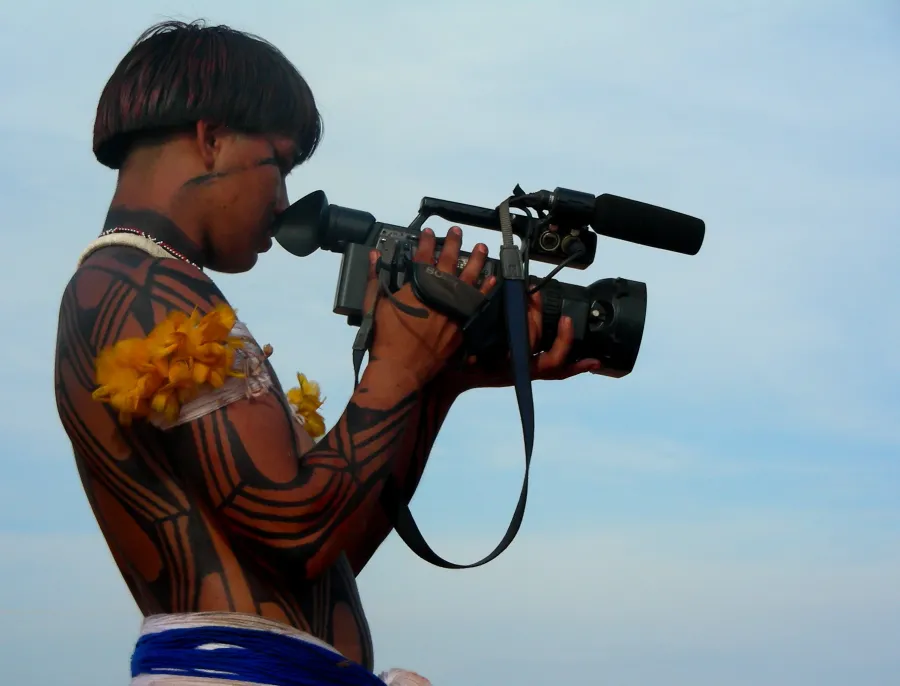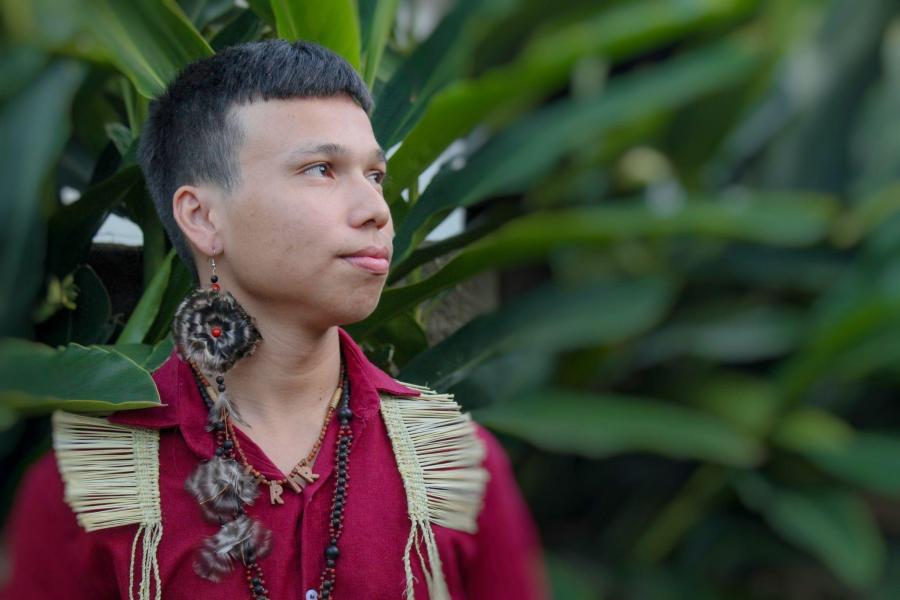Empowering Local Communities in Land-Use Management: The Chico Mendes. Extractive Reserve, Acre, Brazil
Tropical forests have a gained renown as the major reservoir for terrestrial biological diversity and as important reservoir for biospheric carbon that can affect hear trapping gases in the atmosphere. These forests also house traditional communities that have developed unique approaches to use these ecosystems. In Latin America these forests are the site of some of the most active frontier expansion of modern times. Brazil alone has seen an internal migration of over a million colonists, miners, loggers, and ranchers to its Amazonia in the past few decades. The flux of migrants to these forests has accelerated the conversion of Amazonian ecosystems and has created conflicts with traditional communities of the region.
One of the great challenge for conservation and development in the humid tropics is to involve local communities in the management of forests and associated ecosystems. Many proposals have a top-down approach where the reserve or settlement area is decided upon at a government level; local communities are consulted, if at all, at the end of the process.
An innovative experiment in the Brazilian Amazon began as a bottom-up movement in the mid-1980s. Local rural worker's unions and the National Council of Rubber Tappers proposed the establishment of extractive reserves to resolve the sine qua non problem of sustainable development by local communities: the land tenure issue.
At present many of the legal battles for creating extractive reserves are being resolved; residents are now faced with the more complex task of making these experiments in multiple land-use work. A necessary step in this process involves determining the distribution of populations, natural resources, transportation networks, health problems, and other factors that influence present and future patterns of land-use. In short, thematic maps are needed of these reserves.
EXTRACTIVE RESERVES
In extractive reserves the land is owned by the federal government, with the case of the land and its resources bequeathed to traditional dwellers. The administration of these areas in the joint responsibility of IBAMA, the Brazilian Institute of Environment and Natural Renewable Resources, together with local communities. The objective of such a partitioning of land ownership is to eliminate land speculation and conflict as destablizing factors for extractivists.
In spite of their official name, extractive reserves are multiple-use areas that include agricultural as well as extractive activities. The concept of extractive reserves and settlements has been the subject of active debate (Alegretti 1990; Browder 1992; Fearnside 1989; Anderson 1992; Homma 1992). Extractive reserves are not the panacea for rainforest conservation and development, but one of several options, albeit one of the few in which local communities have played a major role. They represent experiments in their initial stages; if they survive their birth, it will be decades before they can be judged successes.
Any attempts to describe current land-use and plan future land-use require geographic information typically embodied in maps. Consequently, organizations that participate in administration of reserves, such as the National Council of Rubber Tappers, local unions of rural workers, and IBAMA, have articulated most strongly the need for mapping.
Another equally important role for mapping is to help forge a new political and social identify for the residents of these reserves. In many cases, the prior social unit, a seringal or former rubber estate, is much smaller than an extractive reserve. Consequently, residents must modify radically their perspective of their territory, if they are to participate effectively in management of extractive reserves.
THE CHICO MENDS EXTRACTIVE RESERVE
The Chico Mendes Extractive Reserve (CMER), named after the murdered rubber tapper leader, differs in several aspects from other reserves. First, it is by far the largest, covering nearly one million hectares that encompass a variety of forest types and over forty seringals in eastern Acre State (Figure 1). Transportation to the regional urban center, Rio Branco, for some communities can be accomplished in a few hours, while for others it may take four to five days. Second, access to some border regions of the reserve may become relatively easy if the highway bordering it becomes linked to a Pacific port. This road/sea access to Pacific Rim countries could result in increased land conflict as land values rise along the highway (Martins 1994). Third, commercially, valuable trees, such as mahogany, are relatively abundant in the forests of the CMER, and many parts of the reserves with access by roads or rivers are or soon will be subject to intense logging pressures. Fourth, the level of political organization within the reserve varies tremendously, ranging from strong and active organization to remote and isolated rubber tappers who don't even know that they live within an extractive reserve. These characteristics make the CMER highly heterogeneous, dynamic, and a challenge for land-use planning.
In developed countries, maps for land-use planning are usually available with the necessary detail and are periodically updated. The planning may then proceed by combinating various types of maps, such as of soils, transportation networks, etc. in a geographic information system. In many developing countries, however, the basic maps have inadequate detail, are out-of-date or inaccurate, or all three. In the case of eastern Acre, the most recent and detailed maps are based on surveys in 1977 at 1:100,000 scale (one centimeter on the map represents one kilometers on the ground). The seventeen-year period (1977-1994) incorporates many of the most important changes in land cover in the region with the installation of large cattle ranches and colonization projects, the results of which are not recorded on the maps available. IN other parts of Brazilian Amazonia, the lack of accurate, generally accepted maps has helped generate a profusion of conflicting land claims. Various maps are then generated to validate these varied claims, creating a "War of Maps" (Monteiro 1994).
At alternative approach to produce up-dated maps is to use satellite imagery as a base for mapping land cover. with such land cover analysis, the land use can often be inferred. For example, rectangular cleared areas of 100 to 1000 hectares are typically pastures for cattle ranches, while irregular clearings of one to ten hectares in size in the midst of forests are generally made by extractivists to cultivate annual crops.
The details of how to do such mapping are discussed below. More important issues are "For whom are these maps?" and "Who will use them"" Typically, the use of maps is concentrated in government institutions; rarely do they reach the local communities. In this case, the mapping of the CMER was the direct solicitation by the National Council of Rubber Tappers. The Council needed the maps to consolidate information about the CMER for extension activities. In addition, the Council found itself stymied in negotiations with brazilian and international agencies due to the lack of information about the reserve. This situation is common among many local communities in Amazonia when they must both plan land-use and justify it to government officials.
MATERIALS AND METHODS
The images used for mapping are from the satellite Landsat TM with a spatial resolution of 30m: that is, the individual picture elements or "pixels" register the intensity of light reflected from ground units of 30m x 30m. While objects of smaller dimensions, such as houses and individual trees, are typically not able to be discerned, linear features like roads and skidding trails can often be detected. The reflected light is divided into spectral bands, three in the visible spectrum and three in the infrared spectrum. (Landsat TM also has a thermal infrared band with 12 m resolution, but it was not considered for our studies.)
For mapping purposes, the most important characteristic of these bands is the contrast between objects of interest and their surroundings. Our first step in mapping the CMER has been to identify the small clearings associated with colocaçoes (singular "colacaçao"), the land area encompassing the trails of rubber trees that the family units taps. Typically, the total area of the colocaçao is on the order of 200 to 800 hectares, while the clearing where the family house and subsistence agriculture and located covers between one to ten hectares. The best contrast between the surrounding forest and these family clearings occurs in the spectral bands 3 and 5, the red and middle infrared bands, respectively. In these bands, the forests appear dark and the clearings light (Brown al. 1992). The mapping is done on black and white images of 1:100,000 scales, purchased directly from INPE, the Brazilian Space Institute, or of 1:75,000 scale derived from computer compatible tapes from INPE, Idrist 4.1 software, IBM-compatible computers, and ink jet printers. More recently, we have used pencil tracings of clearings from these images for field work in order to minimize wear and tear of images and to allow various groups to map at the same time.
Much of the information available from residents in the reserve is referenced to where families live. In order to create detailed thematic maps, our first step has been to map the location of more than 1,000 families that live in the CMER. Naming the family clearings, however, can only be done with the active participation of presidents of the communities. We have found this participation to be most effective when residents gather for meetings with union representatives or during other similar activities. Once rubber tappers understand that these maps will enable them to communicate with other rubber tappers, union representatives, and government officials, we begin the mapping exercise.
If we are in a family clearing that is on the map, we orient the north of map to coincide with geographic north. Then we ask rubber tapers to estimate the length and breadth of the clearing and then try to find one with similar dimensions on the image or tracing. For example, a clearing of 500 m by 200 m appears as a light area of 5 mm by 2 mm on an image of 1:100,000 scale.
Once rubber tappers localize one clearing, other family clearings are usually identified rapidly. Rubber tappers superimpose their "mental maps" with the image and typically produce a map of clearings over thousands of hectares in a few hours. Once drawn on tracing paper, these map are then transcribed at the state agency responsible for forest cover estimates (FUNTAC). The last step involves creating a digital map of the area, using software packages Rootspro, Tosca 2.0, and Idrisi 4.1 Figures 2.3, and 4 show a typical sequence of these steps for the Sao Pedro Seringal.
A COMMUNITY EFFORT
Approximately 200,000 hectares (~20%) of the CMER have been mapped to the level of family clearings. Paper maps of these areas are already being used by rural union leaders and the National Council of Rubber Tappers. Indeed, these paper maps meet the initial demands for the mapping. They have been used to show incursions of loggers into one seringal and to help plan the implantation of agrofoestry systems in another. Five people are now capable of supervising such mapping and dozens of local residents now are capable of interpreting maps.
Our training in mapping generated unanticipated demands for more education in practical mathematics. At our meetings rubber tappers began requesting a more comprehensive education program that would include mapping and other quantitative skills, such as how to calculate the number of seedlings needed in agroforestry systems or how to measure wood volume. The rubber tappers know that mastery of such tools will be essential if they are to become autonomous managers of the reserve.
Much of our current effort involve the digitalization of maps and construction of a geographic information system (GIS). The rationale for such work is that settlements in the CMER are dynamic with migration of population, new clearings developed and old clearings abandoned. In one visit to a seringal we found three new clearings that had appeared in the previous nine months, so even our image of one year ago was already out of date. using digitized data, updating maps becomes relatively east and the integration of socioeconomic and natural resource data becomes possible.
This approach is not without its dangers. As Eastman et al. (1993)noted, computerization may result in the creation of an elite that uses GIS, exacerbating the differences between those who know and those who don't. We believe that computerization is a necessary step for a new model of how local communities can use tropical forests. As with mapping the family clearings, the expansion of this information base will only the possible with the active participation of residents of the CMER. The diminishing cost of this technology has meant that computers with sufficient power to run GIS software are now available at the regional headquarters of the rural workers' unions and at a regional headquarters of the rural workers' unions and at a local university. A recent graduate in agronomy, not a specialist in GIS, is now primarily responsible for construction of this system. Currently, the limiting factor for implementation of this approach at the local level is not hardware, but the restricted time that rubber tapper leaders and union representatives have for such activities.
An example of how low cost can result in technology transfer and encourage education is the use of GPS (global Positioning System) units to provide latitude and longitude of family clearings. Because of price decreased in recent years, we have been able to use such units as an adjunct to our mapping and to test their accuracy. In our visits to local communities, the use of GPS generated interest among residents in learning geography and about what latitude and longitude represent. With an inflatable globe we were able to show them the logic behind the coordinate system and the place of Acre in the world.
The mapping of the Chico Mendes Extractive Reserve has served two purposes. It has helped generated information necessary for the management of the Reserve. More importantly, however, it has stimulated dozens of rubber tappers to learn more about their Reserve and encouraged them to develop the mathematical told that will be necessary not only to use maps, but also to help local communities decide their own fate. During the continued mapping of the CMER we anticipate that rubber tappers will continue to take more responsibility for the mapping and posterior quality control, as well as to expand this mapping to other areas. Already one rubber tapper is using the images to analyze other extractive reserves and inform leaders about problems of logging activities.
If populations continue to grow in the reserve, these communities will be faced with issues of biotic impoverishment and new demands for resources in the near future. Mapping, GIS, and mathematics by themselves will not ensure the success of extractive reserves. Nevertheless, they are essential tools that local communities will need in order to address their land-use issues.
Article copyright Cultural Survival, Inc.



